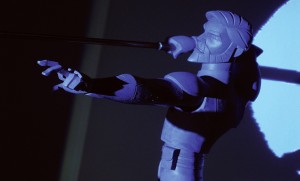Shoot: The force is strong with this one…
 George Lucas has expanded his star wars universe yet again. Miguel Gonzalez spoke with Justin Mettam, an Aussie who is using the force as a 3d story artist.
George Lucas has expanded his star wars universe yet again. Miguel Gonzalez spoke with Justin Mettam, an Aussie who is using the force as a 3d story artist.
“At Lucas Animation we go straight from the script into 3D layout,” Mettam explains about the process that skips the traditional storyboard stage. “The job description of 3D story artist was developed as Lucas Animation,” Mettam says. “3D story is the merging of traditional drawn storyboarding and 3D layout. Lucas wanted to create a piece of software that would help the director previsualise the story; something much more sophisticated than traditional animatics, allowing the director to move around the virtual set in 3D, block out the acting and shoot it, then cut it all together in the same piece of software.
The team starts by discussing the script, to understand the relationships between characters. “[Supervising director] Dave Filoni knows the Star Wars universe better than anyone, with the exception of George Lucas. He really drives these meetings and communicates [what the story needs] to the episodic director and the 3D story team.” The script is then divided and given to the 3D story team. Laying out the story in 3D is ‘the fun part of the job’. “At the end of four weeks, a team of four 3D story artists should have the 20 minute episode blocked out and in editorial. The final four weeks are about finessing what we have created, and at the end we should have a solid story laid out in 3D and ready for the animator and lighters to work with.”

